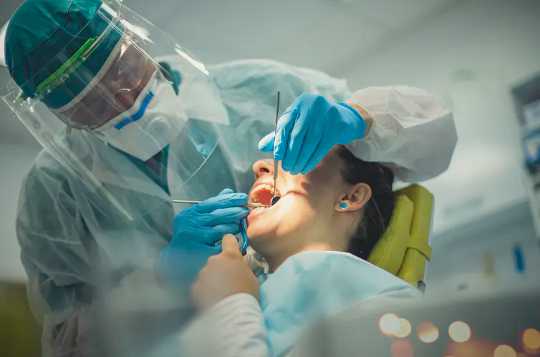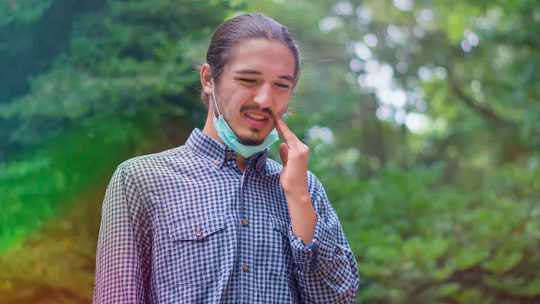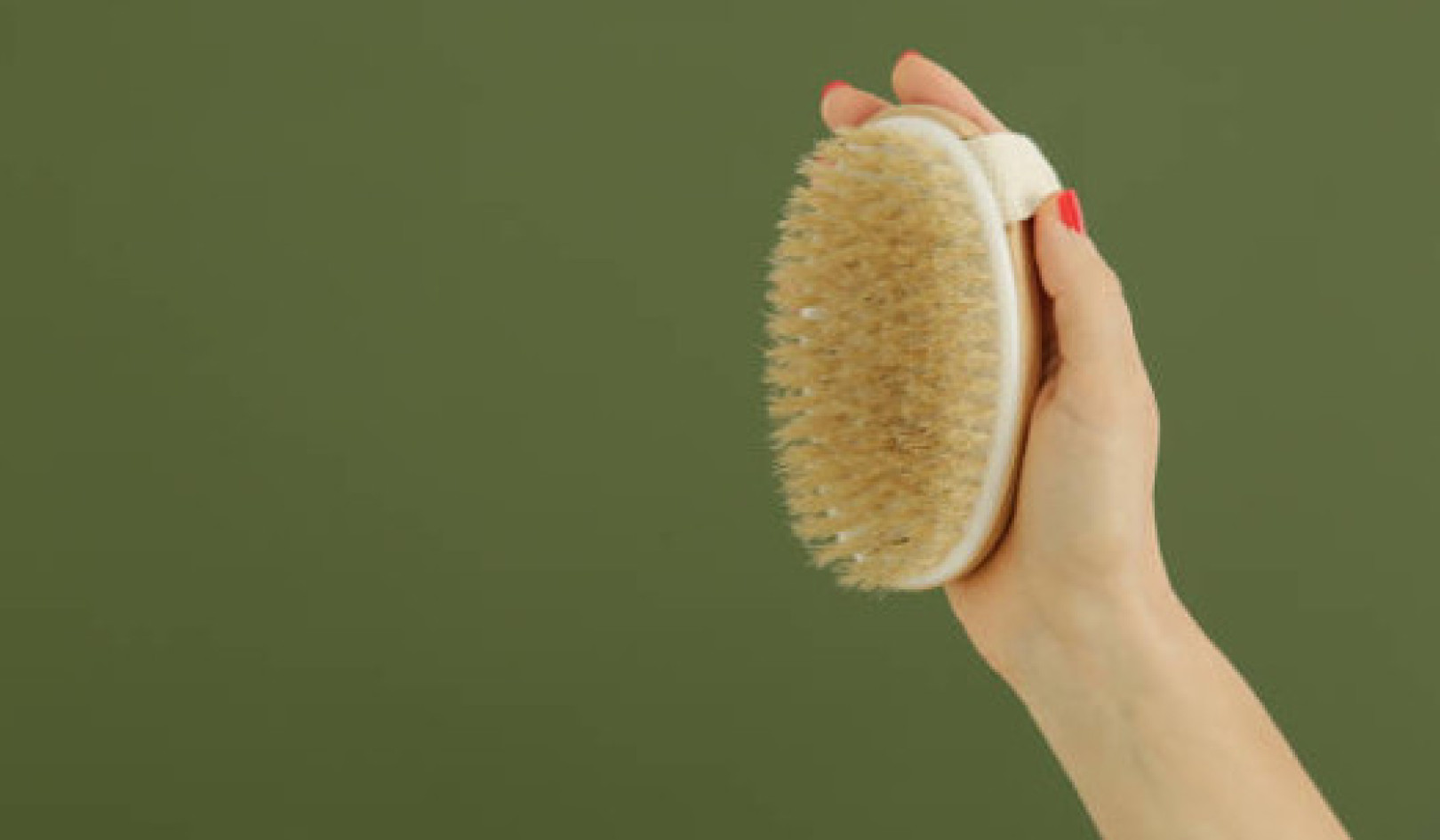 Your dentist should wear appropriate personal protective equipment. LukaTDB via Getty Images
Your dentist should wear appropriate personal protective equipment. LukaTDB via Getty Images
Dental care remains critical for tens of millions of Americans, even during the pandemic. More than one-quarter of U.S. adults live with untreated tooth decay, with nearly half of adults over 30 showing signs of gum disease. And nearly 1 in 4 adults report having felt pain in or around their mouth in the past year.
Poor oral health is associated with numerous chronic diseases, including heart disease and diabetes. These problems pose an immediate health risk and require urgent care. Yet, less urgent dental conditions can have long-term negative effects as well.
But how can you visit your dentist during a pandemic? As a professor, I can tell you that dentists have made many changes to the way your care is provided to improve safety. You should still go, but if you are high risk, you should discuss with your dentist first. Here are some things you need to know – and do – before visiting.
Home care: More critical than ever
With dentists worldwide postponing nonurgent dental treatment, your home care is your first line of defense. Consuming carbohydrates and the subsequent secretion of acid by oral bacteria is what causes tooth decay. Chronic inflammation of the tissues supporting your teeth is called gum, or periodontal, disease. Both conditions are exacerbated by poor diet, tobacco use, a weakened immune system and poor oral hygiene.
Get The Latest By Email
You can battle all of these things by controlling dental plaque - the soft, sticky material on teeth and gums consisting of saliva, food debris and bacteria. Plaque taht remains on teeth for a period of time will form tartar (dental calculus), further promoting bacterial biofilms ecosystems of bacteria that cause dental problems.
 A severe toothache qualifies as a dental emergency. reklamlar via Getty Images
A severe toothache qualifies as a dental emergency. reklamlar via Getty Images
To remove biofilms and plaque, and prevent tartar formation, you must clean all surfaces of the teeth and gums. That means brushing teeth for two minutes, twice a day, using a soft-bristled toothbrush with a fluoride-containing toothpaste. You must also clean the spaces in-between teeth once a day, typically with dental floss.
Studies show an electric toothbrush is more effective at cleaning teeth and gums that a manual one. An alcohol-free mouth rinse helps too, but is not a substitute for brushing or flossing. Over-the-counter mouth rinses with fluoride are available for those at higher risk for tooth decay.
You can also improve oral health with your diet. Limit sugar intake, along with other carbohydrate-containing foods and drinks, such as sodas, fruit juices, sweetened coffee and tea, and candy. You don’t have to completely avoid their consumption, of course, but cutting back on both can be extremely beneficial. Avoid hard and sticky foods that can break teeth and dental work.
COVID-19’s psychological impact has had many indirect effects on oral health. Medications prescribed for depression and anxiety are known to cause dry mouth, which harms oral health. Increased anxiety is linked to bruxism, the clenching or grinding of teeth. More tobacco and alcohol use are not good for your teeth. Poorer diet can lead to many health problems such as gastroesophageal reflux disease (GERD), which can damage teeth.
When to see your dentist
Oral pain may indicate an infection; take it seriously. Broken teeth and dental work are other examples of dental emergencies. In the early weeks of the pandemic, many states mandated the restriction of all non-emergency dental procedures. In response, the University of Florida College of Dentistry, along with many other care providers, instituted teledentistry services. This remote, virtual consultation with a dental professional is one way to help you decide whether to delay care or to visit a dentist.
If you have a loose or failing dental work, try to keep the area clean without further dislodging it. Usually it’s helpful to insert floss around a loose restoration, then gently pull the floss through to the side, to avoid lifting broken dental work out of place. A completely debonded crown can sometimes be temporarily recemented with over-the-counter dental cements or even toothpaste. A teledentistry consultation can help determine if this is appropriate.
A few rare oral problems can constitute life-threatening emergencies. If you have difficulty breathing or swallowing, or uncontrolled bleeding in or around the mouth, seek immediate emergency care. Extreme pain or a high fever associated with dental problems also requires immediate attention.
 Many dental offices now offer teledentistry consults before an in-person visit. Marko Geber via Getty Images
Many dental offices now offer teledentistry consults before an in-person visit. Marko Geber via Getty Images
Changes at the dentist’s office
For decades dental professionals have been sterilizing instruments and disinfecting surfaces. Early reports show a lower COVID-19 prevalence among U.S. dentists than in the general public. With COVID-19, additional precautions are needed. Patients should ask their dentists if they are taking these precautions.
Here’s a brief checklist: First, your dentist’s office should screen you and other patients for COVID-19 symptoms. The office may call you in the days leading up to your appointment to make sure you don’t have symptoms. You may be asked to come to your appointment alone, wear a mask, and wash your hands while at the office.
When you arrive, you may be asked to wait outside or in your car until your appointment time. Waiting areas should have fewer chairs, all properly spaced. All magazines and toys should be removed.
Dental staff should wear appropriate personal protective equipment (PPE), including an N95 mask, along with protective gowns, head coverings, gloves, and face shields. Disposable barriers should cover commonly touched surfaces. Air quality controls, such as HEPA filters, single-pass air circulation, and negative pressure should be in use; they help to contain any aerosols generated during dental procedures.
You may be asked to rinse your mouth with a solution containing diluted hydrogen peroxide. This will decrease the viral load prior to your dental procedure. High-volume evacuation, more commonly known as dental suction, should be used for all procedures that may generate aerosols.
The good news is this: the new safety measures now in place may be sufficient to prevent infection in dental settings. Still, you must consult with a dental professional to help determine the need for treatment. Ass the COVID-19 pandemic evolves, and new research becomes available, expect more changes at your dentist’s office.
About The Author
Andrew J. Corsaro, Clinical Assistant Professor, College of Dentistry, University of Florida
This article is republished from The Conversation under a Creative Commons license. Read the original article.
books_health







